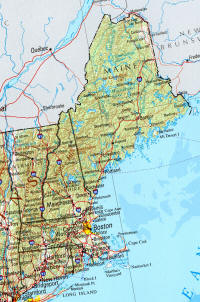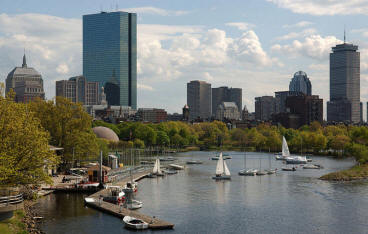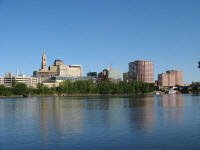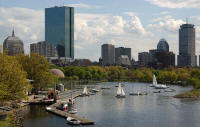Vick & Del's Fall Foliage Adventure
New England is a region of the United States located in the northeastern corner of the country, consisting of the states of Maine, New Hampshire, Vermont, Massachusetts, Rhode Island, and Connecticut.
Time to hop a plane and go to Boston to see the turning of the leaves. Boston is the capital and most populous city in the Commonwealth of Massachusetts. The largest city in New England, Boston is considered the unofficial economic and cultural center of the entire New England region.
The city of Boston, which had an estimated population of 596,763 in 2006, lies at the center of America's eleventh-largest metropolitan area, known as Greater Boston, home to over 5.8 million people.
It is also part of a wider region that includes the nearby cities of Worcester, Providence, and Manchester, with a population of 7.4 million. Residents of Boston are called Bostonians.
Part One: Salem, Bar Harbor, and Quebec

Into the hot rod Chrysler 300
and off we go!
Salem is just outside Boston so that was our first destination. Salem is a city in Essex County, Massachusetts, United States. The population was 40,407 at the 2000 census.
We decided to go to Quebec and the best way was to go through Bar Harbor Maine. Bar Harbor is a town on Mount Desert Island in Hancock County, Maine, United States. As of the 2000 census, its population was 4,820. A port of entry for Bay Ferries from Yarmouth, Nova Scotia, Bar Harbor is a famous summer colony in the Down East region of Maine.
Quebec - Quebec in French, Québec is a province in Canada, and the only one whose people have been declared a nation within Canada.
Please join us on the adventure as we have posted about 80 pictures of the sights and activities we enjoyed.
Part Two: Robert Frost, Billings Farm, Franconia and The Shaker Village
The oral tradition of the Shakers, gathered at the death of Mother Ann Lee, insists on two dates for the origin of their movement: 1706, the coming of five "French prophets" to London, well recorded in historical sources as camisards from Cévennes in the south of France after a five-year against the king of France, prophesying the end of times to gather English popular Puritans for the final Armageddon. The second one, 1747, is the first contact of Mother Ann Lee with James Wardley, a preacher who maintained in a small group the "possession by the spirit" of the French prophets. This oral tradition has not found written confirmation, but is consistent with the 18th-century history of English Protestantism, the relegation of popular Puritanism to small groups very reluctant to appear in public as did their Elizabethan ancestors.
Part Three: Hartford, Mark Twain, and H,B, Stowe
After Dutch explorer Adriaen Block visited the area in 1614, fur traders from the New Netherland colony set up trade at Fort Goede Hoop (Good Hope) at the confluence of the Connecticut River and the Park River[5] as early as 1623 but abandoned their post by 1654. The neighborhood near the site is still known as Dutch Point. The first English settlers arrived in 1635. The settlement was originally called Newtown, but was renamed, Hartford in 1637. One theory about the origins of the name "Hartford" was to honor the English town of Hertford.
Part Four: Cambridge & Boston
In 1630, Puritan colonists from England founded the city on the Shawmut Peninsula. During the late eighteenth century Boston was the location of several major events during the American Revolution including the Boston Massacre and the Boston Tea Party. Several early battles of the American Revolution, such as the Battle of Bunker Hill and the Siege of Boston, occurred within the city and surrounding areas. After American independence Boston became a major shipping port and manufacturing center, and its rich history now attracts 16.3 million visitors annually. The city was the site of several firsts, including America's first public school, Boston Latin School (1635), and first college, Harvard College (1636), in neighboring Cambridge. Boston is also home to the first subway system in the United States.



